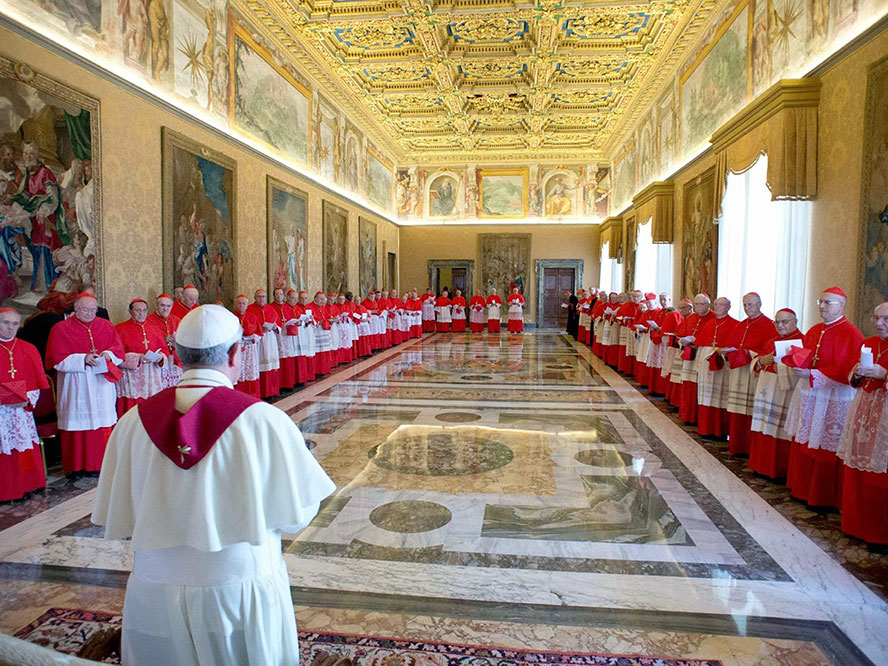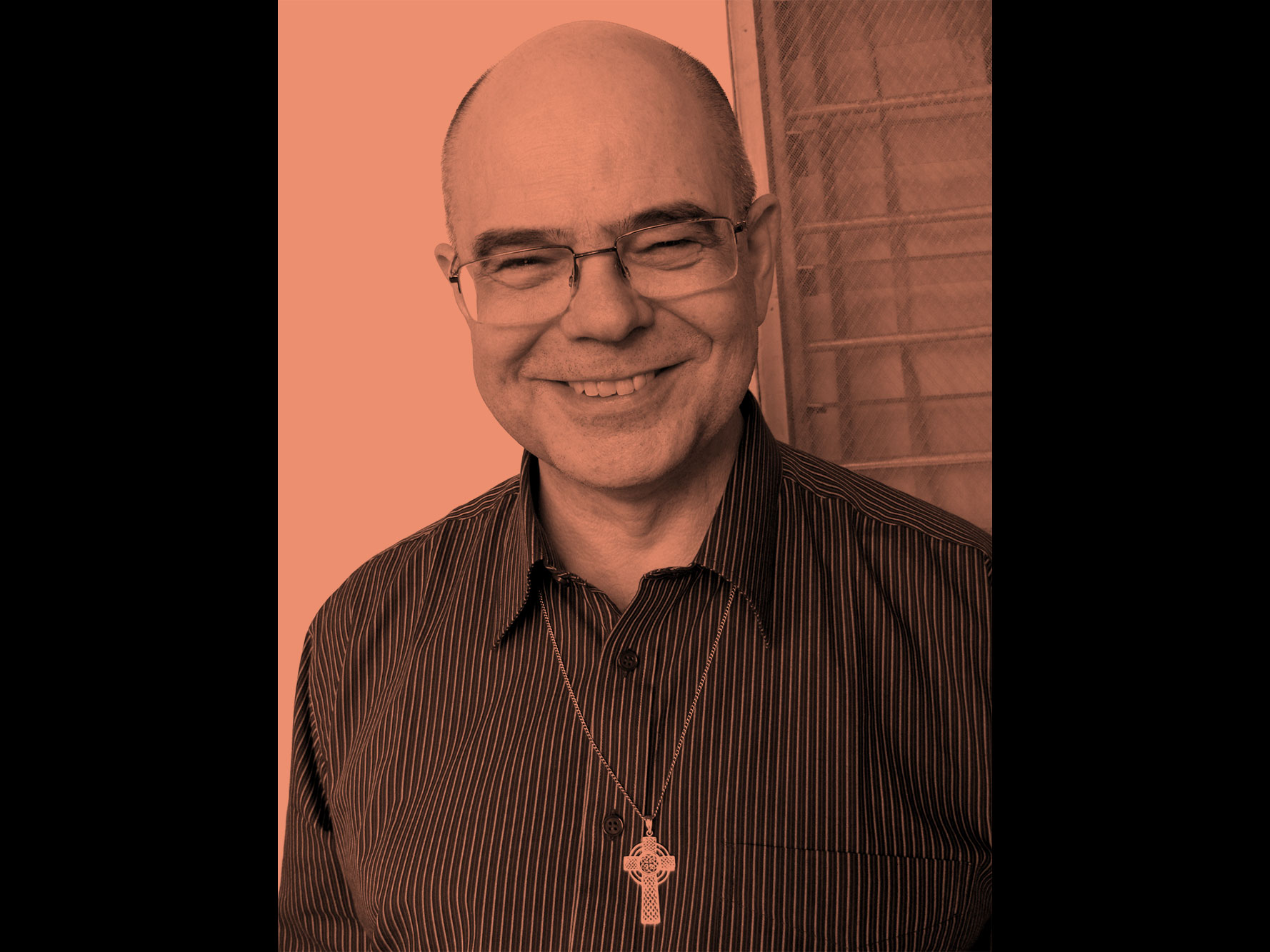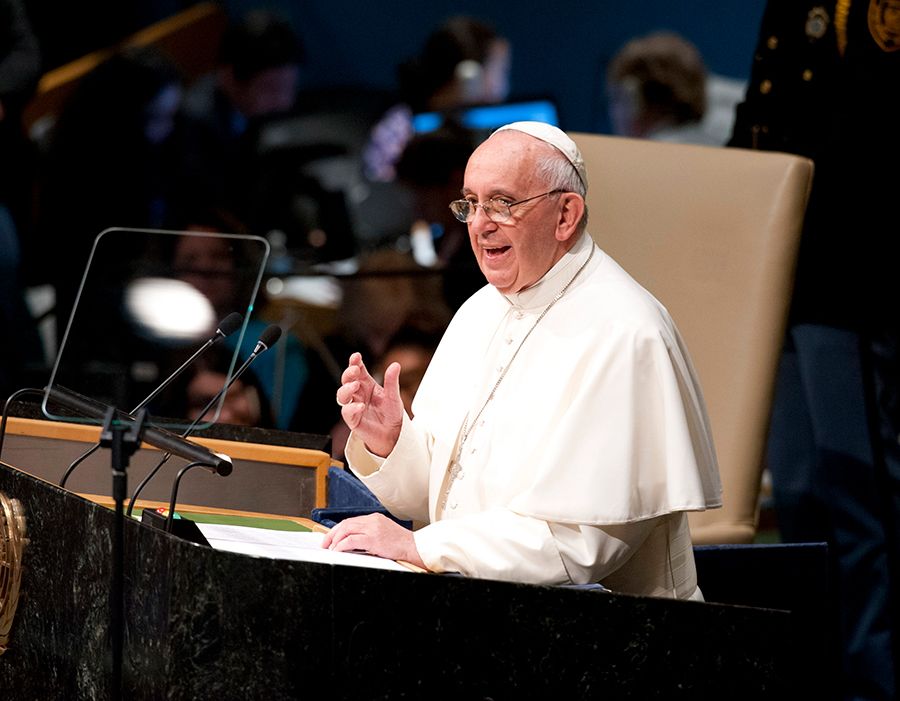From His mouth, unpopular concepts like renunciation, cross, endurance, zeal, courage, and missionary work sounded like a call for growth and an irresistible invitation to heroism. This is what made the challenge to go and “announce (the Gospel) from the housetops” (Mt 10:27) so compelling. Millions took up that challenge and their Message was received with enthusiasm in every land.
FROM THE UPPER CHAMBER TO HOUSETOPS
Having received such a powerful Message, there is no doubt that the Christian communicator would want to be heard. However, a word of caution must be offered to those who want to communicate this Message. The eagerness for winning attention is so great in human beings that the communicator can get lost amid the techniques and tools that are available to him today. Therefore, there is the danger of forgetting about the content and depth that his Message represents, a depth that can only come from an “intimacy” with Christ who is close to the bosom of the Father.
In fact, proclamation without deepening the Message through personal prayer and serious discussion among ardent believers would be too superficial. That is why Jesus Himself discussed His Message intimately with His disciples in the ‘Upper Room’ before reaching out with concern to the masses, who were like sheep without a shepherd. He had compassion, first and foremost, for the receivers of His Message.
CHRIST’S CONCERN FOR HUMANITY
Aside from intimacy, “concern” should be emphasized when speaking about Christian communication. Christian communication is not about gadget skills and high decibels, but about Christ’s concern for humanity, His love for the wrongdoer, the poor, the needy, the marginalized and the least privileged. His was a message of hope.
Christian communication is an invitation to creative thinking on behalf of the human family in order to bring together individuals and communities that have lost their sense of belonging or have been excluded from society. It seeks to reduce tensions, narrow gaps, build bridges, and bring into existence a network of compassion, peace, and reconciliation. It promotes co-thinking about common projects that advance the cause of communion and, ultimately, lead to togetherness in Christ.
Christian communication is, therefore, about constructing human relationships, generating hope and joy, evoking a sense of responsibility for the common good, and eliciting common commitment to humanity’s ultimate destiny.
JESUS ON THE MOUNT, ON THE BOAT
Armed with a genuine concern for the receivers of the Message, the Christian communicator then begins to seek out the scattered sheep. During ancient wars, the good news of victory was announced from high places. Jesus used this imagery of announcing the Good News from “housetops” as the way to propagate His Message. He Himself chose to speak from a mountaintop, a hillside, or a fisherman’s boat to communicate to more people more effectively. The crowds were so captivated by the power of His words that they forgot how hungry they were (Mt 15:32).
SPOKEN TO WRITTEN LITERATURE
As more and more began to receive the Message, the Christian communicator had to look for ways to propagate the Message further. The Apostle Paul, for example, wanted his Message to reach as many people as possible. That is why he sought out places where crowds gathered: synagogues, marketplaces, seaside and festivities. His letters were circulated widely in the Roman world. These letters provoked thought, transformed communities, and won attention, something that even Socrates, Plato or Aristotle were not able to achieve in their lifetime.
Similarly, missionaries like Saints Patrick and Boniface met communities on the roadside and at tribal gatherings to communicate the Message of Jesus. They followed it up by initiating education and promoting written literature to help their followers deepen their understanding of the Christian teaching.
Monks in succeeding centuries continued the tradition of promoting written wisdom and spent entire lifetimes copying Greek and Latin classics, while transcribing the Scriptures and the writings of early Christian Fathers. Their massive contribution to civilization as a whole, to progressive thought, and to the development of the means of social communications in later times cannot be underestimated.
THE PRINTED WORD
Johannes Gutenberg revolutionized Western society through the printed word, changing listening communities to reading communities and stimulating collective and individual intellectual effort. This new system of communication brought a new world into existence, especially for the Christian communicator. Not only did the Bible reach every home; there was an unprecedented flowering of literature in every European language. Literacy spread, educational standards rose, concepts of democracy and participation gathered strength. Such intense intellectual interactions raised large sections of society to new heights.
The printed word reigned supreme for about 450 years before the radio and TV revolutionized the world yet again. In the 1960’s, Marshall McLuhan felt that the world was fast becoming a ‘global village.’ Indeed, it was. Communication among persons used to be likened to discussions between King Arthur and his Knights at the “round table” or to “coffee table” discussion groups. But because of modern technology, people can now communicate instantly with those who are far away, as if they are near. Discussions, debates, major decisions or the changing of people’s minds are accomplished, as though people are just on the other side of that “round table.”
McLuhan’s other predictions also came true, i.e., that new media would change collective self-awareness and bring into existence a new self-consciousness as the human family, and that it would strengthen people’s sense of responsibility for world events.
VATICAN II ON THE MEDIA
However, with the emergence of modern communications media, the traditional concepts of religion and morality began to be seriously questioned. Therefore, the Church felt a renewed need to respond and to express itself, and to communicate the Message to a fast-changing world. This was done through Vatican II.
Inter Mirifica, the Vatican II decree on the media of social communications, recognized the new forms of communication to propagate information. It hailed the modern means of communications for bringing humanity together through the sharing of information and ideas (IM 5). However, it insisted that the information shared through these means should be true and complete.
This meant that the ways of searching for news and the manner of reporting should be responsible, the opinions expressed are within bounds of charity and justice, and that the entertainment offered respects the norms of morality, rights of individuals and communities, and the dignity of the human person. The duty of newsmen, writers, actors, producers, and critics is to contribute to the common good, and not to exploit the weakness of young people or hurt the sensitivities of religious believers (IM 11). Public authorities must fulfill their responsibility, safeguarding spiritual values, promoting arts, and protecting health (IM 12).
The document also acknowledged that sound public opinion is what weighs the most in modern democratic societies (IM 8). It invites Christian communicators, therefore, to go beyond reporting Church-related matters and seek to instill a Christian spirit into the collective thinking of secular society (IM 14). In this way, the Gospel comes alive in public life and evangelical sensitivities are fostered in civil society. As Bossuet said: “It is true I have not converted anybody. But I have converted public opinion, which means I have converted everyone.”
In addition, Inter Mirifica conceded that the portrayal of moral evil can bring about a deeper knowledge and study of humanity. However, it urged moral restraint in such matters, given the baneful effect of original sin (IM 7). Viewers who patronize irresponsible programs cause great spiritual harm (IM 4). That is why it would be better to show how truth and goodness ultimately triumph in human affairs. This, however, can only be done effectively if the producer has developed the necessary artistic skills.
ASIAN FOLK MEDIA
Despite the modern means of communication, Inter Mirifica affirmed the value of the ancient art of drama (IM 14). In Asia, such art forms are called folk media. Being rooted in local cultures, folk media are very popular forms of entertainment and education in rural Asia in spite of the expansion of the modern media. Whether they be in the form of a song or dance, theater or storytelling, puppet show or musical, recitation or declamation, folk media are not as impersonal as the mass media. There are millions of Asians who may have heard the story of Jesus for the first time through such folk media. Thus, Inter Mirifica encouraged the continued use of folk media.
FROM HOUSETOPS TO LAPTOPS
Vatican II Council Fathers could have been speaking in generic terms when they referred to modern communications media in Inter Mirifica. For sure, they could not have imagined the way the digital revolution would transform the world beyond recognition. However, the Council Fathers correctly prophesied how this new media could be used to the Christian communicator’s advantage. In fact, the Vatican was quick to adapt to the digital age by uploading all Church documents on the internet as early as 1995. Other Church agencies took similar initiatives, through blogs, text messaging and social media.
Today, more than one-third of the world’s population has access to the internet. The social consciousness created by new media has profoundly transformed politics, business, education, and the Church itself. Individuals and groups find it easy to establish a public presence at very little cost, each promoting their causes with spectacular success. For example, initiators of the so-called Arab Spring used Facebook and Twitter to stir Egypt, Tunisia and other nations to rise against erring governments.
In the same way, entrepreneurs capture markets and evangelists draw people to the Gospel through these media. In fact, Benedict XVI invited people to become digital missionaries (Vogt 109), an attractive proposal for young Christians.
There is no doubt that people are eager for information, inspiration, encouragement, and connection. That is why when evangelizers speak with fire in their hearts, people know it. When many heed an evangelizer’s message, the resulting action makes an impact. Even a strongly agnostic world cannot ignore a passionate group of believers, even if they constitute a small minority. They speak as having authority. And “You shall receive power…and you shall be my witnesses…to the ends of the earth” (Acts 1:8) and your faith will be “proclaimed in all the world” (Rom 1:8).
TEILHARD’S NOOSPHERE
Benedict XVI observed that the younger generations seem to be “natives” on the “digital continent” while the elders are only “immigrants.” The young have developed a vernacular of their own, think differently from others, and relate among themselves in their own way. They show a preference for small, self-organizing groups, networks, and equality-based relationships.
Such web relationships have brought to postmodern youth a heightened consciousness of togetherness and of human solidarity. They are open to the mystical and spiritual, though deeply immersed in a modern scientific worldview. The world of co-thinking and relationships, the noosphere that Teilhard Chardin spoke about, seems to be emerging in ways unforeseen.
In view of this, Christian communicators and evangelizers now have the opportunity to connect with the youth through social media. However, communicators must know how to relate to them meaningfully. Using the new forms of media, Christian believers must seek to point and lead all things to Jesus, the Way, the Omega Point of Teilhard (Eph 1:10).
SHAPING SOCIETY THRU SOCIAL MEDIA
Among the networks that can be tapped to evangelize is Facebook, which was started by Harvard students in 2004. Only 8 months after its introduction, it gained 200 million users. Meanwhile, in 2008, Google reported over one trillion websites that contain information, images, videos, and sounds, mostly initiated by the young.
Blogs, which were first initiated in 2002, are also perceived to be very youth-friendly platforms for evangelization. One can blog about anything: boxing, music, politics, or even the Catholic Church. Today, there are group blogs, corporate blogs, commercial blogs, and institutional blogs. One can educate, encourage, expose excellence, evaluate, and evangelize through them (The Church and the New Media, Brandon Vogt, pg. 117-19). As long as the approach is natural and spontaneous, blogs remain interesting.
Online requests for prayer are becoming popular. Grandmas and moms take to blogs in order to learn how to do things better, to know more about medicine, childcare, and spiritual experiences. They can keep grandchildren, in-laws, relatives, and family friends linked and religiously motivated.
Catholic bloggers can win the attention of society and contribute towards shaping a healthy public opinion. They can chronicle their ideas, exchange views, debate, comment, and build up new relationships (Vogt 58). Anonymity also can be an advantage for bloggers who desire to remain unknown. But, as encouraged by Inter Mirifica, they must make sure to present balanced views on controversial issues and preserve a human touch on everything.
BUILDING RELATIONSHIPS THRU SOCIAL MEDIA
Parish activities and programs can be announced on the web: blogs, podcasts, news, reflections, homilies, prayers, audios, videos. A Facebook page can be opened. But one should always connect with people in a meaningful and inspiring way.
Online friendships can develop into mature relationships and help strengthen communities. The sense of community that one lacks in a parish may be found in a virtual community. However, in spite of all these advantages, Pope Francis emphasizes the irreplaceable role of person to person encounters (Evangelii Gaudium 127-28).
CHURCH PROGRAMS ON THE WEB
YouTube appeared in 2005 and proved to be a powerful means for sharing the Good News, building communities, and promoting the common good. The more one subscribes to YouTube, the more one realizes how much the whole world is waiting for the Message in the virtual sphere. This seems to be the new Areopagus. The Vatican itself has a heavy presence on YouTube with videos on the activities of the Holy Father.
THE JOY OF THE GOSPEL
Pope Francis has unexpectedly emerged on the world scene as a master communicator, making the “joy of the Gospel” reach the masses. Despite being pope for only a year, he has demonstrated how Christian communicators must act in order to reach out to as many souls as possible, especially in this day and age of modern communications. He continually offers suggestions on how to overcome the contemporary “barriers” that prevent the Message from being communicated effectively.
To begin with, Pope Francis addresses the concerns of the masses using their language, speaking with zest and forcefulness. In his Apostolic Exhortation The Joy of the Gospel, he emphasizes the importance of using a language that people understand (EG 21), and not in the “dull categories” which weaken the “freshness of the Gospel” (EG 11). A relevant human approach has far greater convincing power than a moralistic and doctrinaire tone (EG 142). Fixed formulations will not communicate as easily as meaningful gestures and signs drawn from local cultures (EG 129).
He laments that “in the prevailing culture, priority is given to the outward, the immediate, the visible, the quick, the superficial and the provisional. What is real gives way to appearances.” This has led to the alienation of people from their own cultures and the weakening of their cultural roots (EG 62). Here is where the Christian communicator can be helpful.
The Pope also notices that “new cultures are constantly being born” in cities and that new languages, symbols, messages, paradigms are being developed (EG 73). He says that the Gospel “must reach the places where new narratives and paradigms are being formed.” Jesus must be given to the soul of the cities, in their multicultural contexts with problems like violence and mass protests (EG 74). The Message must also reach professional, scientific, philosophic, and academic circles (EG 132). The Christian communicator can assist people to develop critical thinking about an overload of superficial information (EG 64). A purely sociological analysis will not suffice where an evangelical discernment is called for (EG 50).
Finally, Pope Francis says that having a “missionary heart,” just as in the day of Jesus, will shed all rigidity and defensiveness (EG 45) and respect the hierarchy of truth. He urges Christians to be close to the younger generation since they read the signs of the times better (EG 108). He asks believers to emulate Jesus’ genuine concern about pressing issues like justice, rejection of the unborn child, the girl child, women, marginalized groups, minorities, environment, lack of respect for people of other cultures, religions, and convictions. The Pope invites Christians to commit to rooting out violence and corruption, working for peace, and being generous in compassion.
Only then can the Good News of Jesus be announced once again “from the housetops,” to reach in helpful ways in the worst of situations, to the last person on Earth, and to the whole of creation!































